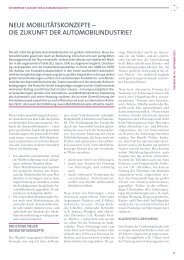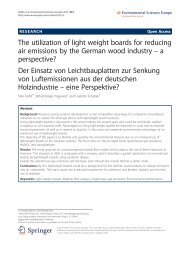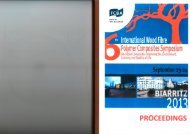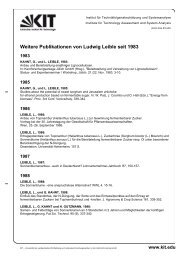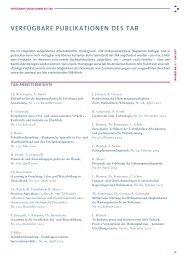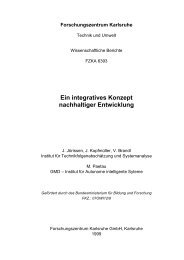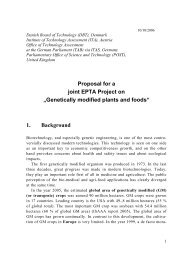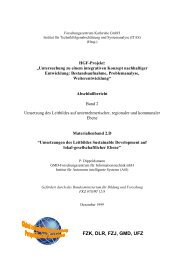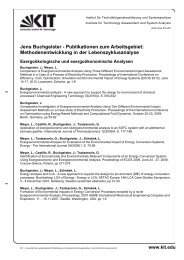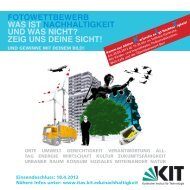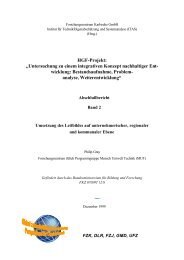Results: RFID and Identity Management in everyday life - ITAS
Results: RFID and Identity Management in everyday life - ITAS
Results: RFID and Identity Management in everyday life - ITAS
Create successful ePaper yourself
Turn your PDF publications into a flip-book with our unique Google optimized e-Paper software.
Case ID #131 , level 1<br />
Title ExxonMobile Speedpass<br />
Researcher Christian van ‘t Hof<br />
Tim<strong>in</strong>g 1997-2006<br />
Geography US, Canada, S<strong>in</strong>gapore, Japan<br />
Environment traffic <strong>and</strong> retail<br />
Case #131: Exxon Mobile Speedpass<br />
Technology The Speedpass consists of a 134kHz <strong>RFID</strong> chip (Texas Instruments) <strong>in</strong> a small black plastic barrel<br />
of about 2 cm which can be carried on a keycha<strong>in</strong>. Readers are placed at the gas dispenser <strong>and</strong><br />
at the cashier. Communication between reader <strong>and</strong> tag is secured through a challenge response<br />
protocol, which works as follows. When the readers sends out its signal, a r<strong>and</strong>om number is<br />
given. The chip performs a mathematical operation on the number, us<strong>in</strong>g its own secret code <strong>and</strong><br />
sends back the result together with its serial number. The readers sends this <strong>in</strong>formation through<br />
satalite communication to the central database <strong>in</strong> Houston, which have lists of all authorised<br />
Speedpass owners, perform the same calculation as the tag <strong>and</strong> compare the result. If the<br />
numbers match, the purchase is made through the customers credit card number. This proves<br />
takes about 3 seconds. [4]<br />
Costs Cost of the <strong>RFID</strong> system: $ 60.000,- for each location. [4] Customers can order <strong>and</strong> use the tag<br />
free of charge.<br />
Maturity fully operational<br />
Function payment<br />
Owner The Speedpass system was developed by ExxonMobil.<br />
Ma<strong>in</strong>ta<strong>in</strong>er ExxonMobile. The radio frequency technology is provided by Texas Instruments <strong>and</strong> <strong>in</strong>tegrated<br />
<strong>in</strong>to the fuel dispensers by the Wayne Division of Dresser Industries.[3]<br />
Users Customers at the gas station<br />
Other actors Trials at McDonalds <strong>and</strong> Stop & Shop.<br />
Case story Speedpass is a <strong>RFID</strong> pay system at ExxonMobile gas stations. The pass consists of a small black<br />
plastic barrel of about 2 cm which can be carried on a keycha<strong>in</strong>. Readers are placed at the pump<br />
<strong>and</strong> cassier. The <strong>RFID</strong> chip <strong>in</strong> the barrel carries a unique code which is connected to the holders<br />
credit card account. It was first <strong>in</strong>troduced at Mobil-br<strong>and</strong>ed service stations <strong>in</strong> 1997 as an easy<br />
<strong>and</strong> fast way to pay at the pump. Soon, the Speedpass system was extended to Mobile’s<br />
convenience stores. After the merger with Exxon, the pass was employed at the Exxon stations<br />
too. By 2003, there were over 5 million activated Speedpasses, account<strong>in</strong>g for 10% of sales at the<br />
pump. In 2005, Speedpass is deployed at 8,600 locations throughout the US. [4]<br />
Dur<strong>in</strong>g it’s implementation phase, several trial were held to extend the reach of the Speedpass<br />
system. In 2001, ExxonMobile started trials at 450 McDonalds <strong>in</strong> the Chicago area <strong>and</strong> <strong>in</strong> 2003<br />
with Stop & Shop supermarkets to see whether the pay system could be extended to fast food<br />
<strong>and</strong> groceries. Speedpass was origionally employes just for pay<strong>in</strong>g gas, but accord<strong>in</strong>g to Joe<br />
Giordano, vice president of systems en product development at Speedpass their customers<br />
expressed the need to use it at other “around-the-town, convenience oriented-type purchases”.<br />
Still, for some reason or another, we were unable to f<strong>in</strong>d many accounts of this use today.<br />
More than 6 million Speedpass devices have been issued <strong>in</strong> the U.S. Exxon- <strong>and</strong> Mobil-br<strong>and</strong>ed<br />
service stations <strong>and</strong> convenience stores <strong>in</strong> the U.S. There are more than 8,800 locationsExxon-<br />
<strong>and</strong> Mobil-br<strong>and</strong>ed service stations <strong>and</strong> convenience stores <strong>in</strong> the U.S. <strong>in</strong> the U.S. that accept<br />
Speedpass. Research shows that more than 90 percent of Speedpass users report they are<br />
highly satisfied. Nearly 2 million Speedpass devices have been issued <strong>in</strong> Canada, S<strong>in</strong>gapore <strong>and</strong><br />
Japan for use at more than 1,600 retail locations <strong>in</strong> those countries. [3]<br />
Each device has a unique identification <strong>and</strong> security code that is transmitted to the<br />
reader when you make a purchase. The purchase is automatically charged to the<br />
payment method l<strong>in</strong>ked to the Speedpass device. The customer’s credit or check<br />
card number (or check<strong>in</strong>g account number) <strong>and</strong> personal <strong>in</strong>formation are never<br />
91



